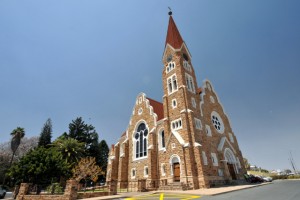Namibia’s colonial German heritage is evident in the capital city, where neo-baroque cathedrals and castles sit next to steel and glass high rises. Color is everywhere. Windhoek doesn’t look like your typical African capital. Not only is it quite safe, it also doesn’t have the same architectural clutter found in so many other major cities across the continent. But while Windhoek feels almost provincial when compared to Johannesburg or Lagos, in Namibia it stands as a strong testament to modernity in a sparsely populated country. If you devote yourself to 48 hours in Windhoek, you’ll be sure to fall in love with its laid-back charm, its uncluttered colonial-meets-African architecture, its residents, and its posh bars and restaurants sprinkled across the eastern suburbs.
Day 1
Namibia is one of youngest countries in the world, only gaining independence in 1990, and as such, its capital is the place to experience its modern culture and energy, and get a feel for what this vibrant nation is all about. Begin at the brightly colored Post Street Mall. An elevated pedestrian walkway, it serves as Windhoek’s main shopping district and is filled with vendors selling everything from clothing to curios, to local art and jewelry. The mall is also home to coffee shops and eateries. Grab a seat at one and listen to the jumble of languages being spoken around you – Namibia is home to 11 major ethnic groups and The Guardian reports that up to 30 different languages are spoken in this country. That’s a lot, considering Namibia has a population of just over 2 million. It also has one of the lowest population densities in the world, averaging around 3 people per square kilometer.
In the middle of the outdoor mall, you’ll find a sculpture made from 33 meteorites that fell during the Gibeon meteor shower millennia ago. The boulders did not originally land in Windhoek, but were transported here from the town of Gibeon where the shower dumped 21 tons of mostly ferrous iron rocks – one of the heaviest ever recorded – some 600 million years ago. The Nama people originally discovered the meteorite and turned the fragments into weapons and tools. Today, pieces are incorporated in local jewelry designs.
When you’ve finished looking at prehistoric extraterrestrial rocks, grab some takeaway from one of the vendors at the mall, and head over to Zoo Park to learn about another prehistoric event – a Stone Age elephant hunt. The remains of two elephants and a couple of quartz tools were found here in the early 1960s, and today you can learn about the discovery at the park’s elephant column, which is the work of Namibian sculptor Dorthe Berner and depict carvings of the ancient elephant hunt. An elephant skull fossil also sits on top of the sculpture. The park is a popular local picnic spot. Unpack yours and enjoy it under the palm trees on deep green lawn.
After lunch, continue the history lesson exploring the west side of Independence Ave, which is home to three impressive colonial buildings designed by German architect Willi Sander at the turn of the 20th century. Note the roofs of the three homes are pitched – they were designed in European style to prevent snow accumulation. The city’s most famous building, the art nouveau meets neo-Gothic Christus Kirche, built from local sandstone in 1907, is also in this area. Standing on a traffic island in the CBD, the German Lutheran church is impossible to miss, a striking piece of architecture that manages to amalgamate two completely different styles.
After checking into Windhoek’s most royal B&B, the historic Hotel Heinitzburg, which is located inside a castle commissioned in 1914 by Count von Schwerin for his fiancée Margarethe von Heinitz, have dinner at the onsite restaurant, Leo’s. This eatery is Windhoek’s finest dining experience and has served real royals before.
Following dinner, grab a taxi to Joe’s Beer House, which is Windhoek’s most legendary drinking spot, and always packed with locals, expats, and tourists. You’ll find a huge choice of Namibian and German beers, with plenty of tables under a faux African boma.
Day 2
Windhoek was founded in the 1890s by German soldiers – by comparison, the first Europeans arrived in Cape Town in the mid 1600s. Alte Feste is Windhoek’s oldest surviving building, a stately whitewashed affair dating back to the early 1890s. It also houses the historical section of the State Museum with exhibits on Namibia’s independence struggle, as well as some truly bizarre displays. Don’t miss the champagne glasses used by representatives from South Africa, Angola, and Cuba to toast peace.
The National Art Gallery is also worth a visit, and features work by local artists in various mediums, some of which is for sale. It also houses a permanent collection of works reflecting Namibia’s history and nature.
In the afternoon head to the beautiful Daan Viljoen Game Park that sits in the Khomas Hochland about 18km west of Windhoek. Because there are no dangerous animals, hikers can wander freely through desert-like hills and valleys. You’ll almost certainly see gemsbok, kudu, mountain zebra, springbok, hartebeest, eland and up to 200 bird species. The park also has numerous hiking opportunities and a restaurant.
Grab dinner at a Windhoek institution, Luigi & the Fish, which serves all sorts of fish and seafood alongside meat, pizza, and veggie options. Afterwards, it is time to hit the town. Start at El Cubano for a little Havana in Africa. It is a popular lounge that does excellent mojitos, and is the place to puff on an imported Cuban cigar. Clubs don’t get going before 11 p.m., at which point you can head to Funky Lab or La Dee Da’s for dancing – the latter focuses on several African styles.



